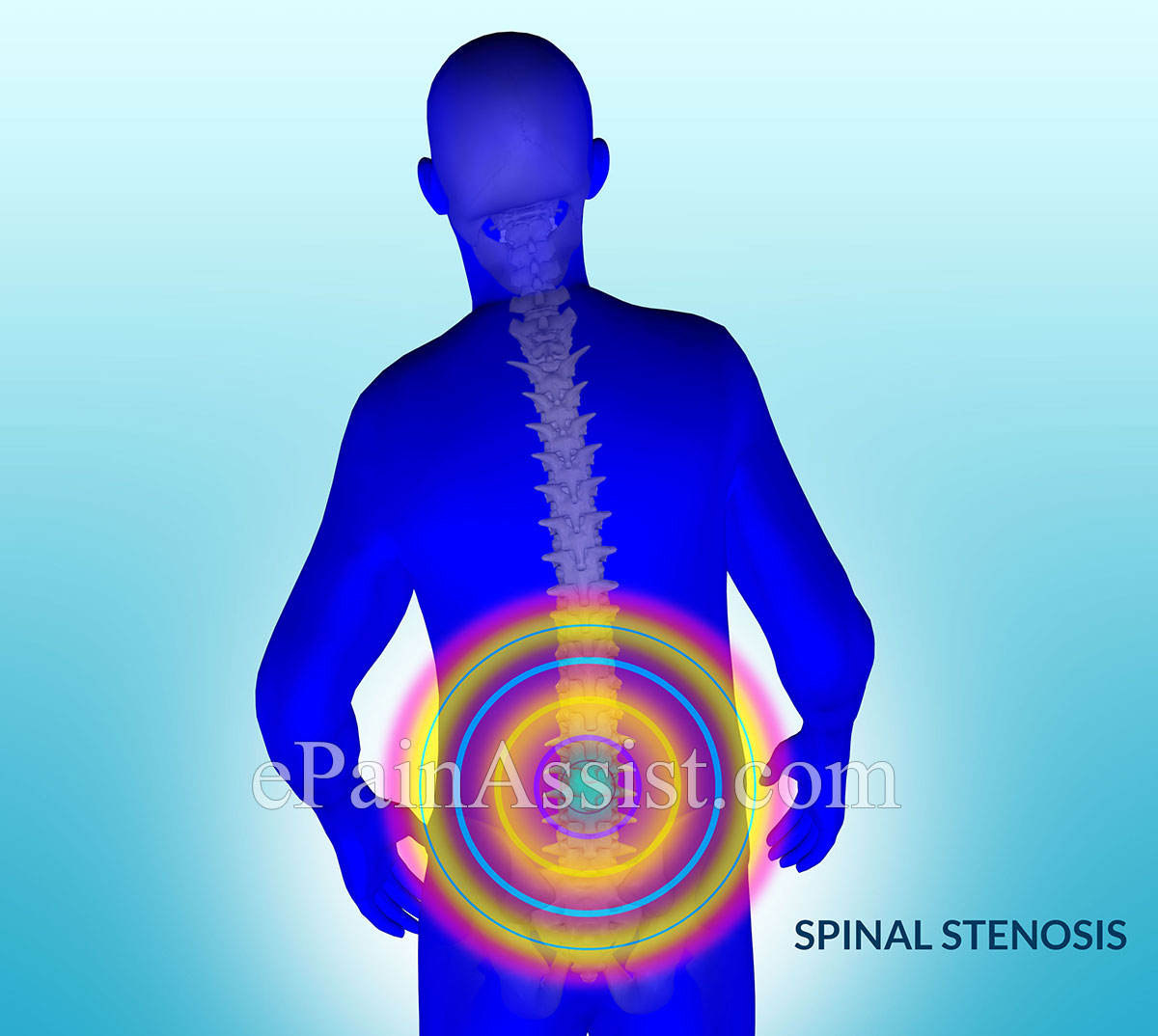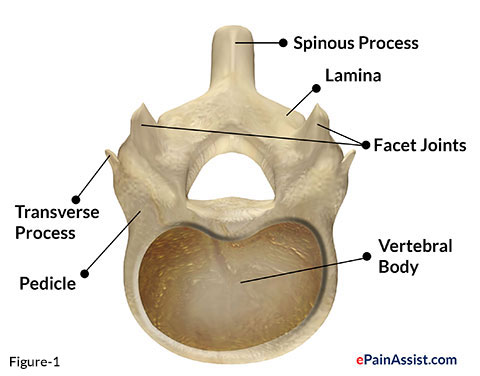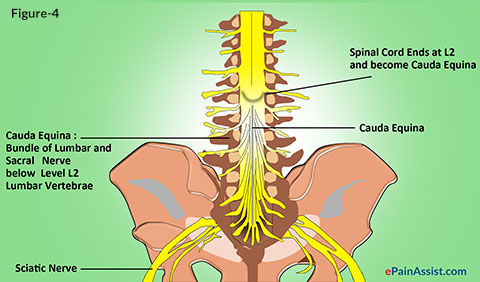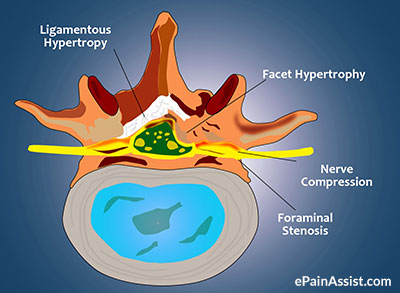
Backbone is also known as vertebral column. Vertebral column extends from base of the skull to coccyx. Vertebral column is made up of 33 vertebrae. Vertebrae are divided into two groups known as 24 articulating and 9 fused vertebrae. Twenty-four articulating vertebrae are cervical (7- C1 to C7), thoracic (12- T1 to T12) and lumbar vertebra (5- L1 to L5). Nine fused vertebrae are sacral (5- S1 to S5) and coccygeal (4) vertebrae. Articulating vertebrae are separated by disc in cervical, thoracic, and lumbar segment. Vertebra is made up of anterior solid bone known as vertebral body and posterior bony ring. Skeletal or bony ring is formed by pedicle, articular process of facet joint and lamina (figure 1). The circumferential gap between upper and lower bony ring is covered by ligaments. Vertebral canal is thus cylindrical in shape and spreads from base of skull to sacrum. Spinal cord, cerebrospinal fluid (CSF) and three spinal meninges (Pia, Arachnoid and Dura) are enclosed in spinal canal. Cerebrospinal fluid lies between pia and arachnoid spinal meninges (figure 2) known as subarachnoid space. Bony ring, meninges and CSF protects spinal cord.


Growth or abnormal structure in spinal canal causes narrowing of the spinal canal. Spinal stenosis is the term used to describe narrowing of the spinal canal (Figure 3 and 4).

Cauda Equina-
Spinal cord splits into multiple nerves below the level of L2 lumbar vertebrae. Lumbar and sacral spinal nerves L3, L4, L5, S1, S2 and S3 nerves are bundled as a tail of horse below the level of lumbar vertebra L2. The bundle of nerves is known as Cauda Equina.

Causes of Lumbar Spinal Stenosis
Lumbar Disc Bulge– Large lumbar disc when bulge into spinal canal occupies significant space resulting in spinal stenosis. Spinal stenosis secondary to disc bulge results in compression of spinal cord above lumbar vertebrae L2 and cauda equina below level L2.
Lumbar Disc Herniation– Lumbar disc herniation within the spinal canal causes pressure on spinal cord and cauda equina as described in disc bulge. Pain is at time severe, sharp and continuous if herniation of disc is associated with disc fragment dislodged in spinal canal causing continuous irritation of nerves.
Lumbar Spondylolisthesis or Subluxation– Severe spinal stenosis occurs with grade 3 or 4 subluxation of lumbar vertebrae. Spondylolisthesis is an anterior or posterior slide or subluxation of lumbar vertebrae over adjacent disc. Spondylolisthesis is described as grade 1, 2, 3 or 4 spondylolisthesis. Grade 1 subluxation or slide is less than 25%, grade 2 is between 25 and 50% and Grade 3 over 50% of vertebral surface slipped over disc. Lumbar spondylolisthesis causes narrowing of lumbar spinal canal and intervertebral foramina. Narrowing of spinal canal results in spinal stenosis.
Primary and Metastatic Cancer of Vertebrae– Primary or metastatic cancer of vertebrae often protrudes in to spinal canal and occupies significant space resulting in spinal stenosis.
Lumbar Vertebral Body Fracture– Fragments of lumbar vertebral fracture protrude in lumbar spinal canal. Posterior projection of fracture segments into spinal canal causes spinal stenosis. Causes of Lumbar Vertebral Fracture are as follows-
- Automobile accident.
- Work accident.
- Fall.
Hypertrophy of Lumbar Ligamentum Flavum– Ligamentum flavum is one of the strong ligament, which lies anterior to lumbar pedicle, facet joint, and lamina. Ligamentum flavum hypertrophy or thickening results in protrusion of ligament in to spinal canal resulting in spinal stenosis.
Lumbar Facet Joint Disease– Facet joint lies posteriorly between pedicle and lamina. Hypertrophy of facet or Zygapophysial joint causes projection of the joint and it’s coverings into spinal canal resulting in spinal stenosis.
Causes of facet joint disease are as follows-
- Joint Hypmertrophy.
- Arthritis- Osteoarthritis, rheumatoid arthritis and psoriatic arthritis.
- Fracture Fragents.

Bony Spurs of Vertebrae– Large bone spurs are rare. Occasional large spurs bulges into spinal canal and causes spinal stenosis.
Lumbar Epidural Abscess– Lumbar epidural abscess expands into spinal canal resulting in spinal stenosis.
Clinical Symptoms and Signs of Lumbar Spinal Stenosis
Symptoms of Lumbar Spinal Stenosis
Chronic Pain Caused by Lumbar Spinal Stenosis
Spinal stenosis causes discomfort while standing in 94% cases.
- Radicular Pain– Radicular pain is a dermatomal pain caused by pinch or irritation of sensory nerve fibers. Pain is distributed in dermatome of the nerve and dermatomal pain is known as radicular pain.
- Radiculopathy– Radiculopathy is diagnosed when radicular pain is associated with tingling, numbness or weakness in lower extremities. Spinal stenosis if not treated aggressively then numbness and weakness become permanent impairment. Sensory and motor nerve damage may lead to disability.
- Intermittent Claudication– Intermittent claudication symptoms are characteristics of spinal stenosis. Symptoms of claudication are as follows.
- Radicular Pain
- Lower Weakness
- Bilateral Numbness and Paresthesia
- Prolonged standing or walking causes weakness and heaviness in buttocks and lower extremities.
- Symptoms are exaggerated with extension of spine and relieved with flexion of spine.
- Symptoms are relieved in seating or supine position during early phase of spinal stenosis.
- Bladder and Bowel Incontinence– Sacral nerves S1, S2 and S3 are bundled in cauda equina. Irritation or pinch of sacral nerves caused by spinal stenosis results in bladder and bowel incontinence.
- Cauda Equina Syndrome-Pressure, pinch or irritation of sensory, motor and autonomic nerves bundled within cauda equina causes sensory, motor and autonomic symptoms. Symptoms of cauda equina syndrome are as follows-
- Radicular Pain in Lower Extremity.
- Numbness of Lower Extremity Pain, Perineum and Buttocks.
- Weakness of Lower Extremity.
- Bladder and Bowel Dysfunction- Incontinence.
- Fever– Mostly seen if spinal stenosis is caused by epidural abscess or infected tumor mass.
Signs of Lumbar Spinal Stenosis
- Gait Disturbance– Spinal stenosis often causes weakness and numbness in lower extremity resulting in gait changes. Gait changes may be associated with tendency to fall if muscle weakness is associated with muscle atrophy. Patient may need walking assistance like cane or walker.
- Postural Deformity- Normal posture depends on paravertebral and gluteal muscles tone and power. Irritation and pinch of motor nerve (nerves to muscles) causes weakness and atrophy of paravertebral and gluteal muscles resulting in postural deformity.
- Weight Loss Weight loss is observed in spinal stenosis caused by epidural abscess or malignancies.
- Muscle Atrophy Spinal stenosis causing motor nerve damage results in muscle atrophy. Examination of leg muscles indicates wastage of group of muscles. Muscle atrophy follows abnormal gait and difficulties in ambulation.
- Reflexes- Spinal stenosis causes abnormal knee and ankle joint reflexes. Knee joint reflex is absent or diminished as a result of damage or pinched L2 and L3 Nerve.
- Ankle reflex (tendo-achillis reflex) is diminished or absent when L4, L5 and S1 nerve is damaged or pinched.
Investigations to Diagnose Lumbar Spinal Stenosis
- MRI Examination– MRI is useful in the diagnosis of spinal stenosis caused by epidural abscess, tumor growth, hypertrophy of ligamentum flavum, facet joint hypertrophy, and disc bulge and disc herniation. MRI pictures show details of spinal canal and surrounding structure.
- CAT Scan– CAT Scan is an alternative study to MRI. CAT scan is often done after myelogram to see the details of structure within spinal canals.
- Erythrocyte Sedimentation Rate (ESR) – Abnormal ESR is observed in epidural abscess or infected cancer tissue causing pinched nerve pain.
- C-Reactive Protein– Hypertrophy of synovium and facet joint in rheumatoid or Psoriatic Arthritis causes mild to moderate symptomatic spinal stenosis. C-reactive protein is positive in rheumatoid or psoriatic arthritis.
- White Blood Cell Counts– Epidural abscess or Osteomyelitis infection causes increased white blood cell count.
- X-Ray– X-ray pictures do not show details of disc and soft tissue. Bony abnormalities are observed in X-Ray pictures. Degenerative Disk Disease and Spondylolisthesis are often diagnosed with X-Ray and MRI or CAT scan studies are done to evaluate further details.
- Myelogram– Myelogram study shows details of spinal canal. Dye is injected in to spinal canal and X-Ray or CAT scan pictures are taken following injection of dye in to spinal canal. Myelogram study is specific to evaluate extent and spread of spinal stenosis.
- EMG- Electromyography– Spinal stenosis causes sensory, motor and autonomic nerve damage. Electromyography studies are performed to evaluate sensory and motor nerve damage.
- Bone Scan– Bone scan study may not be much help. Bone scan study is helpful to diagnose osteoporosis if associated with spinal stenosis.
- Bone Densitometry– Bone densitometer study will show presence of osteoporosis, osteomyelitis and osteoarthritis with spinal stenosis.
- Bladder Retention Study and Cystoscopy– Spinal stenosis causes pinch or irritation of sacral autonomic nerves resulting in urinary and bower incontinence. Several other diseases cause bladder incontinence. Cystoscopy and bladder retention study is performed to evaluate different causes of bladder retention.
Treatment for Lumbar Spinal Stenosis
Medications for Lumbar Spinal Stenosis
Nonsteroidal Anti-Inflammatory Drugs (NSAIDs) – Prescribed for pain and inflammation. Most prescribed NSAIDs are Aspirin, Ibuprofen (Motrin, Advil) and Naproxen (Aleve).
Tramadol (Ultram or Ultravcet) – Prescribed For Chronic Pain Not Responding To NSAIDs
Opioids as Analgesics
- Short Acting Analgesics
- Prescribed For Breakthrough Pain.
- Hydrocodone- Vicodin, Norco and Loratab
- Oxycodone- OxyIR (Oxycodone Immediate Release)
- Morphine- MS IR (Morphine Sulphate Immediate Release)
- Dilaudid
- Long Acting Opioids
- Prescribed for long-term analgesics
- Methadone
- Oxycodone- Oxycontin
- Morphine- MS Contin
Muscle Relaxant
- Cyclobenzaprine (Flexeril)
- Soma
- Skelaxin
- Robaxin
Anti-Neuropathic Analgesics
Neuropathic pain is treated with Antidepressant.
- Antidepressant Analgesics
- Prescribed for chronic neuropathic pain and depression associated with neuropathic pain.
- Most commonly used antidepressant as analgesics are as follows-Duloxetine,
- Milnacipran and Tricyclic antidepressants (Elavil)
Antiepileptic Analgesics
Neuropathic pain is treated with Antiepileptics or Anticonvulsant medications.
- Antidepressant Analgesics
- Prescribed for chronic neuropathic pain
- Prescribed for depression associated with neuropathic pain. Most common antiepileptics used as analgesics to treat neuropathic pain are as follows-
- Gabapentin- Neurontin.
- Pregabalin- Lyrica.
Antianxiety– Anxiety and muscle pain is treated with antianxiety medications. Most common antianxiety medications used are as follows-
- Diazepam- Valium
- Clonazepam
- Ativan
Interventional Pain Therapy for Lumbar Spinal Stenosis
Corticosteroid injection is effective in treating radicular pain and radiculopathy. Bladder and bowel dysfunction or cauda equina syndrome often does not respond to epidural steroid injection. Corticosteroid is injected in epidural space using one of the following 3 techniques. All three techniques are performed using image intensifier and aseptic technique.
- Trans-laminar Epidural Corticosteroid Injection
- Caudal Corticosteroid Injection
- Trans-Foraminal Epidural Injections
Physical Therapy (PT) for Lumbar Spinal Stenosis
Types of Physical Therapy-
- Passive Physical Therapy
- Heat Application.
- Ice Packs.
- Electrical Stimulation- Tens Unit.
- Active Physical Therapy– Active Exercises- Specific exercises and massage are Stretching. For most low back pain treatments, active exercise is the focus of the physical therapy program.
Surgery for Lumbar Spinal Stenosis
- Explorative Discectomy– Large bulged disc or herniated disc is difficult to remove using percutaneous or endoscopic surgery. Exploratory discectomy is performed following skin incision and exposure of the disc. Indication for explorative discectomy is as follows-
- Lumbar Disc Bulge
- Lumbar Disc Herniation
- Laminectomy– Lamina is a posterior part of vertebral column. Spinal stenosis is narrowing of the spinal canal. The pressure within spinal canal is removed (decompression surgery) by performing total laminectomy surgery.
Surgery is performed for following illnesses-
- Ligamentum Flavum Hypertrophy
- Facet Joint Hypertrophy
- Epidural Abscess
- Spinal Fusion Surgery– Surgery is performed to widen the spinal canal. Surgery includes laminectomy (removal of lamina bone) and posterior instrumentation to stabilize the lumbar vertebrae. Surgery is performed for following illnesses-
- Spondylolisthesis or subluxation of vertebrae.
- Ligamentum flavum hypertrophy.
- Facet joint hypertrophy.
- Discectomy, Laminectomy and Spinal Fusion Surgery– Surgery is performed to widen the spinal canal and remove bulge or herniated disc. Surgery includes discectomy, laminectomy (removal of lamina bone) and posterior instrumentation to stabilize the lumbar vertebrae. Surgery is performed for following illnesses-
- Lumbar disc herniation.
- Lumbar disc bulge.
Also Read:
- Treatment for Back Pain or Backache: Medications, Manual Therapy, Interventional, Surgery
- Disability Benefits For Back Pain
- Minimally Invasive Spine Surgery: Types, Recovery, How is it Done?
- What is Minimally Invasive Spine Surgery & How Effective is it?
- Recovery Time Following ACDF & What to Expect After ACDF Surgery
- What is Dynamic Stabilization & Who is a Candidate For It|Reasons to Prefer Dynamic Stabilization Over Other Fusions & What to Expect in the Recovery Period?
